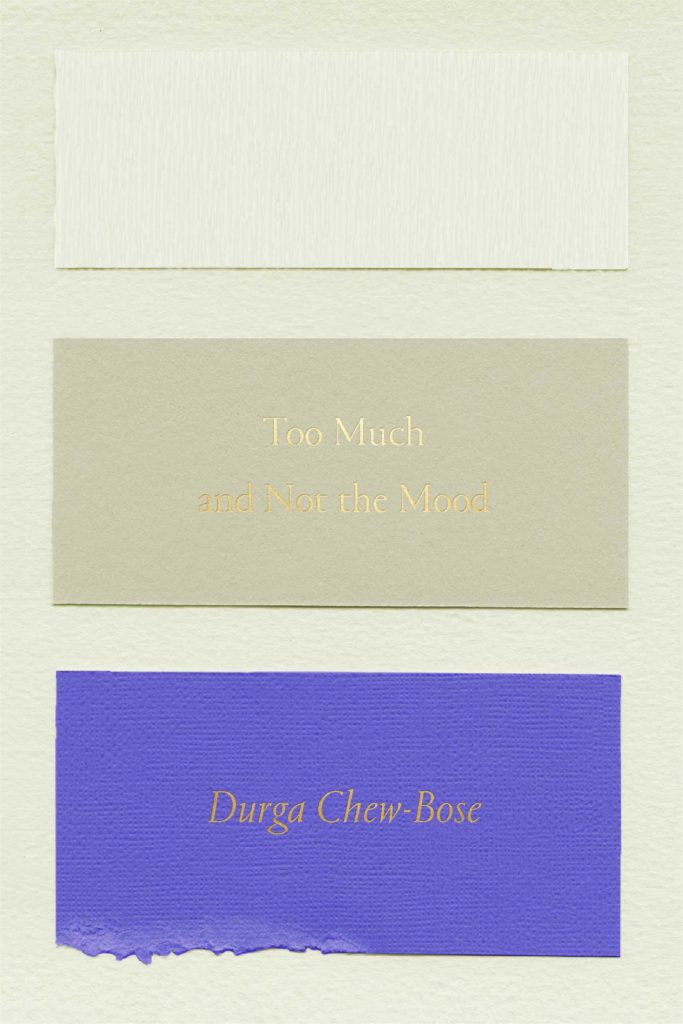Review by Marah Hoffman

Nonfiction | Essays. 240 pages, FSG Originals: NY, New York, 2017. Paperback $15.00. Available Here
The renowned essayist Phillip Lopate once said, “the reason I read nonfiction is to follow an interesting mind.” Durga Chew-Bose’s essay collection Too Much and Not the Mood reminds the reader why creative nonfiction is such a revered art form; her mind is a reader’s wonderland.
Durga sheds an honest, sometimes self-ridiculing light on herself, her evolution, and the way she perceives the world as a resilient, romantic daughter of divorced immigrant parents, and “nook-person” (a sensitive, introverted subset of humanity that she invented herself). The collection is not chronologically organized; it catapults from her twenties to that time when she was seven and then back to her twenties, giving the impression of a puzzle. The reader must slowly collect the complex pieces that compose Durga Chew-Bose. It is a fun process.
“Heart Museum” almost follows a stream-of-consciousness style in that it gains its momentum from tangents. These tangents have the same exciting effect as when a teacher randomly halts the lesson to discuss the peculiar events of their morning. The bridges Durga builds are unstable, but the reader doesn’t mind jumping. Durga declares in the essay, “the best ideas outrun me. That’s why I write.” This philosophy is abundantly evident in “Heart Museum.” She goes from describing all the heart-stopping events our hearts, in fact, continue to beat through to discussing the memories of goldfish to imagining the teenage lives of her grandparents to defining nook people. Durga indeed bounds after her ideas, taking her readers along for the ride.
Because I did not read “Heart Museum” in one sitting, there were times when I would pick up Too Much and Not the Mood and find myself desperately trying to figure out the impossible question, “how did I get here?” But, eventually, I gained the good sense to give up. “Heart Museum” forces readers to practice living in the moment. There are many breath-taking, literary moments for readers to live in throughout “Heart Museum.” One example is when Durga explains the beauty of recognizing your smallness: “the muscle that builds from yielding to my aunt Jennifer’s decades, to the scalloped edges of her memory, reacquaints me to my most atomic self: where I come from. Even when I was nothing, I was arriving.” In the end, the reader does discover that Durga’s tangents had a destination. She achieves her goal of compiling all the innate intricacies of her heart into a personal, relatable heart museum. Durga proves that it is possible to catch your best ideas, even if it takes ninety-three pages.
Too Much and Not the Mood does not slow down after “Heart Museum.” The collection’s second essay, “Part of a Greater Pattern,” starts with the startling first sentence, “the dead squirrel was, without a doubt, going to make me very late for school.” Such a strange first sentence fills the reader with questions such as, “how did the poor squirrel die?” and “why is it going to make her late for school?” Durga, of course, like the wise writer she is, does not answer the questions right away. She lets her readers’ curiosities flare.
Part of the reason Too Much and Not the Mood is able to maintain its speedy pace is Durga’s structuring. All the essays utilize sentence fragments. By building her wonderland with small materials, the collection flows and the reader follows. In Durga’s short, five-page essay “The Girl” she displays her mastery of the fragmented sentences, “The flapping. The clinging. The sucking-in. This turned her on.” Durga’s writing is not flashy. It achieves its impact with subtle skill.
The collection’s sense of rush, strangely, makes the you stop and savor. You reread a line, not because you didn’t understand it the first time, but because it wraps up an emotion so neatly and eloquently you can’t quite believe it. You are so grateful someone else understands. Durga highlights common emotions and experiences in her work like the intimacy of friendship, “I love being in the vicinity of someone I confide in daily, whose posture is indistinguishable.” Too Much and Not the Mood resonates deeply.
Durga’s writing is raw and radiant; she possesses extraordinary literary endurance. The collection’s title was inspired by an entry in Virgina Wolf’s diary where she lamented the constant wondering of whether she had anything worth saying. It is quite clear Durga Chew-Bose has something worth saying.


